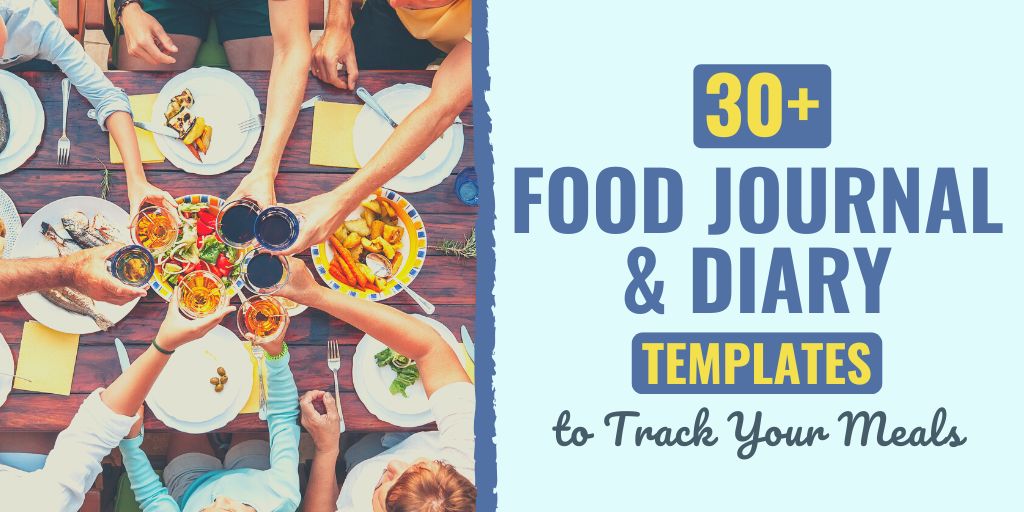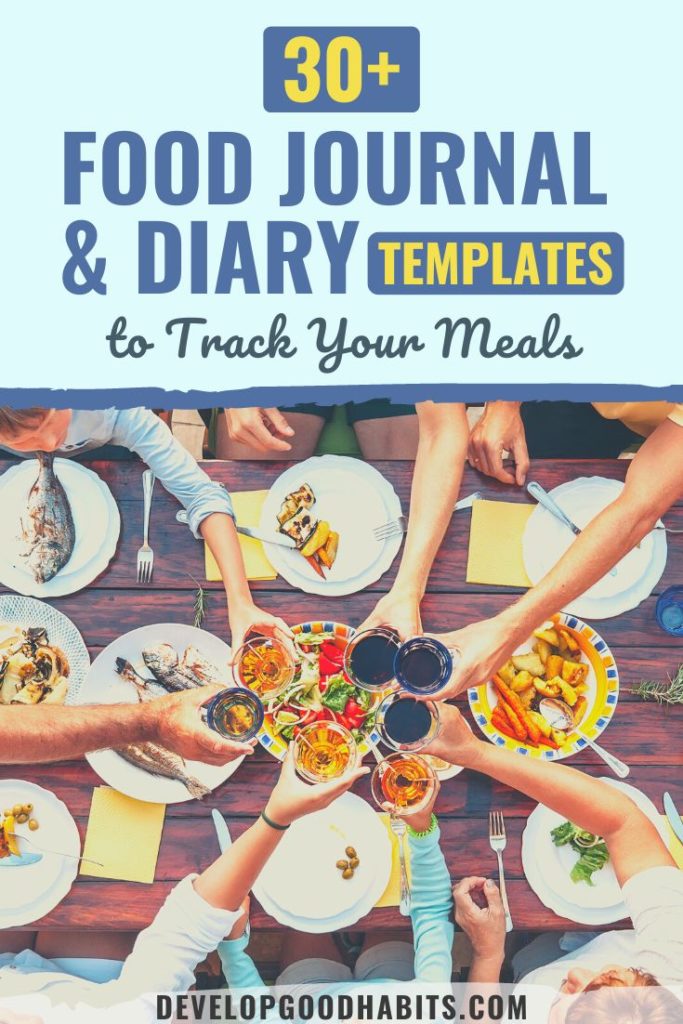As the New Year rolls in, most of us are likely renewing our commitment to take good care of our health. One way to stay on track of health goals is by having a food journaling habit.
A food journal is a useful tool for improving your health. It is a tool you can use to track what you eat at every meal. Keeping a food diary allows you to:
The following guide questions can help make food journaling accurate and successful:
1. What did I eat? – You can write down the types of food you’ve eaten in a meal, and the beverages you’ve consumed. You may also include the kind of food preparation (fried, broiled, etc.) and the condiments used, if any.
2. How much have I eaten? – Record the amount of food you’ve consumed in the measurement system you’re familiar with (e.g., cups, ounces, tablespoons). For extra accuracy, weighing your food before consuming it is a good practice.
3. When did I eat? – Logging the time when you ate is helpful if you’re keeping track of your eating habits. For example, if midnight snacks are a constant part of your bedtime routine, this may be causing problems for your weight-loss goals.
Side bar: One simple health habit you can build is to drink this superfood green drink, which gives you a boost of energy and supplies your body with the nutrients it needs to get through the day. (You can also read the review of it here.)
To help get you started, here are 33 food journal templates you can use as samples to draw inspiration and motivation for your own food diary.
1. My Daily Food Journal
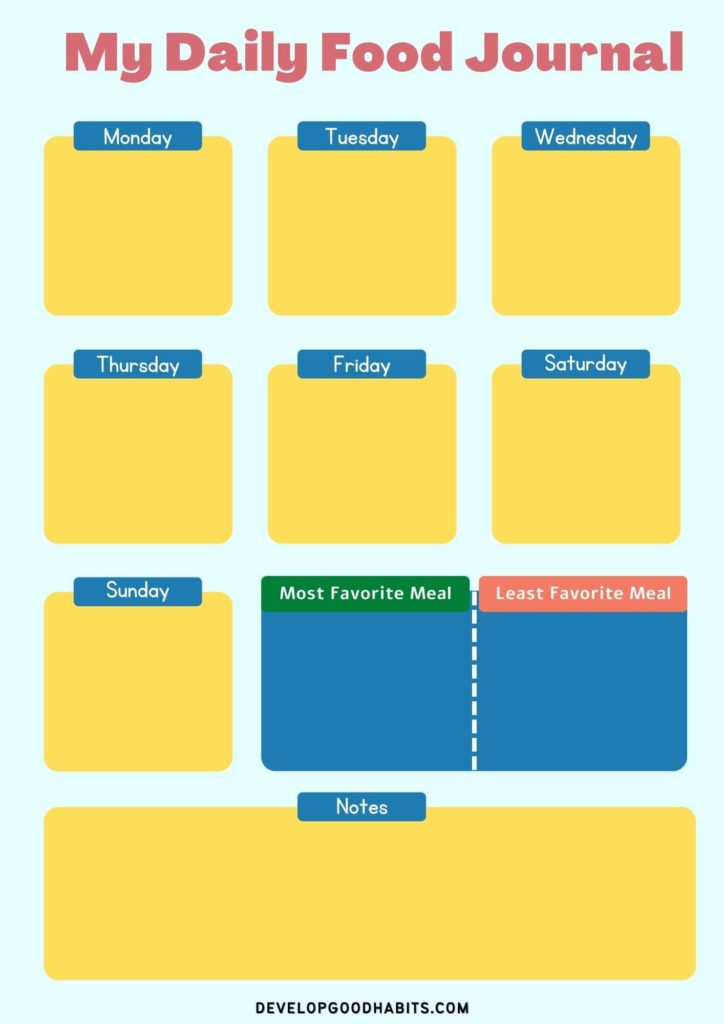
If you’re looking for a food journal that helps you become more mindful at every meal, this template we’ve designed might just be the thing you need. It features a predominantly yellow-and-blue theme, with spaces allocated for keeping a record of every meal for each day the week.
You can also highlight which meals left the best or the worst impression on you through the spaces allocated for “Most Favorite Meal” and “Least Favorite Meal.” At the bottom of the page is enough space for making notes about your weekly meal experience.
2. My Daily Food Planner
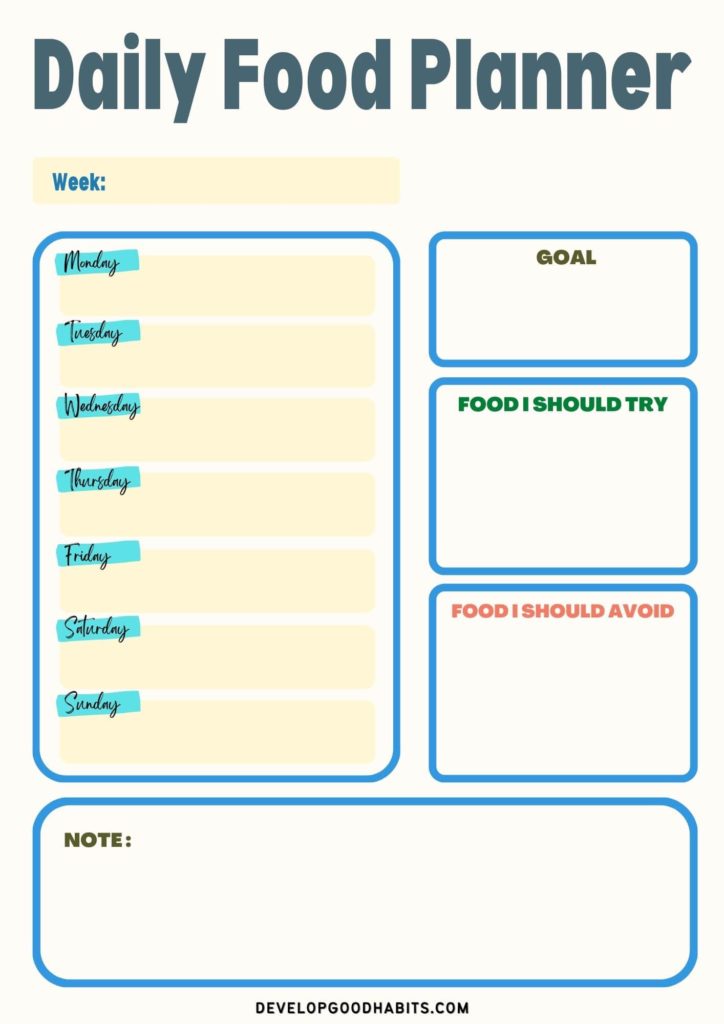
Our Daily Food Planner encourages healthy eating. Space is allocated for your goal, where you can write down what you’re aiming for when it comes to meal prep, health, and nutrition.
We’ve designed this template not only to keep track of your daily meals, but also to encourage users to try a variety of dishes through the space labeled “Food I Should Try,” Conversely, the space “Food I Should Avoid” highlights dishes that might cause allergies or other adverse reactions and should be avoided by the user.
3. My Food Diary
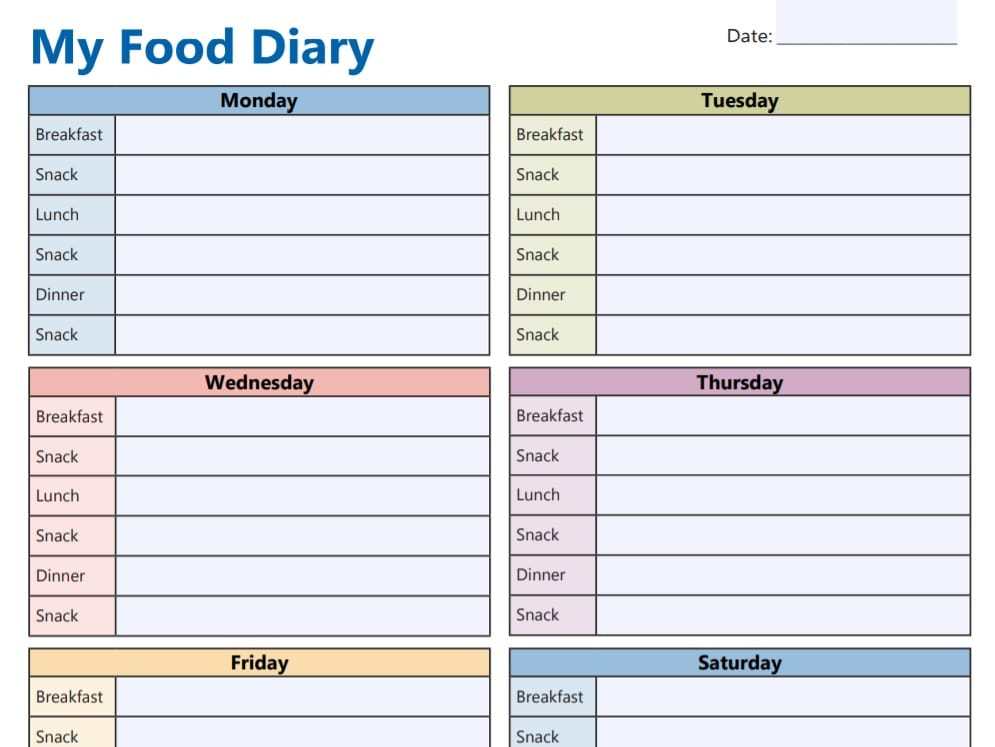
via Centers for Disease Control and Prevention
The CDCP supports people in their efforts to embrace a healthy lifestyle. They have made a simple food diary with enough spaces for users to record their food intake for the whole week.
Each day of the week features a pastel color scheme, and has slots for you to write down or type in the food you’ve eaten for breakfast, lunch, and dinner. There are also three slots for snacks for each day of the week. The diary is in PDF format and downloadable for free from their website.
RELATED: 11 Morning Health Habits to Lose Weight
Want to build a morning routine to shed those extra pounds? Then watch this video to discover the 11 habits to lose weight and feel great:
4. Weekly Food Journal
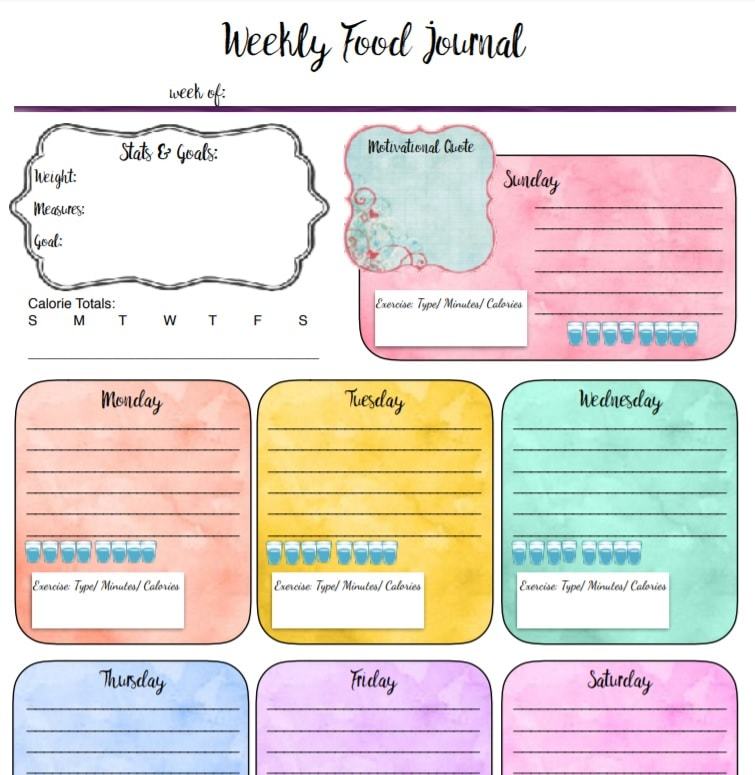
This food journal has ample space for you to list all the types of foods consumed in a week, as well as a tracker for daily water intake. It has a charming design, and to further motivate you, there is an area to write down your motivational quote for the week.
The journal also has spaces reserved for your weekly measures and goals, as well as for the exercises (with duration and calories burned) you’ve done for every day of the week.
5. Daily Food and Activity Diary
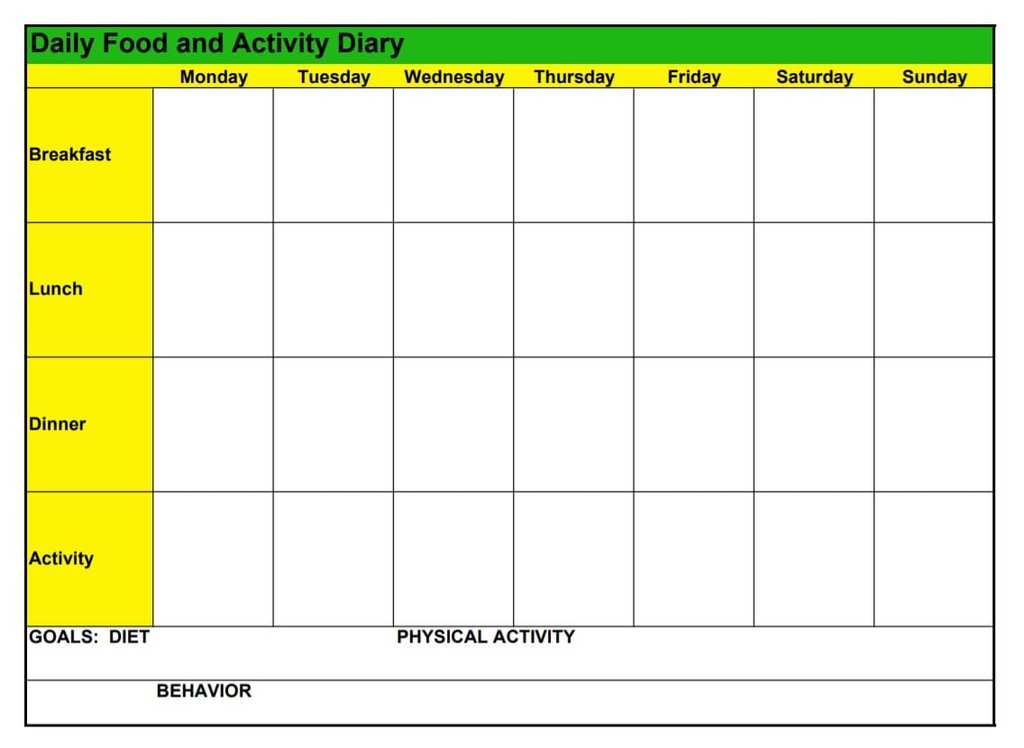
via National Heart, Lung, and Blood Institute
This food journal helps you track your food intake and physical activities for the entire week.
Although there are several ways for you to lose weight, health care experts recommend a combination of a healthy diet and sufficient regular physical activity. At least 2.5 hours of moderately intense aerobic exercise each week is both beneficial and safe for most people.
6. Rainbow Theme Weekly Food Journal
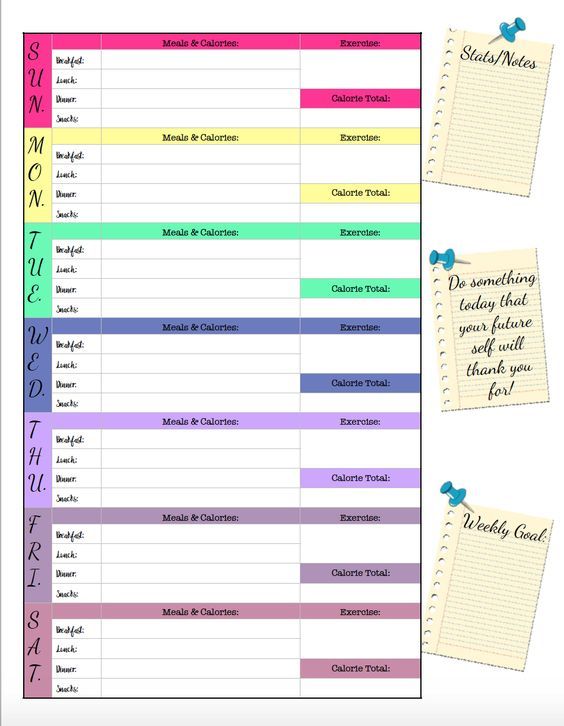
If you prefer a festive theme for your food journal, you might consider adopting this template’s design. This tracker features a space for your weekly goals, statistics and notes, and motivational quotes to get you going.
7. Food Diary and Nutrient Tracker
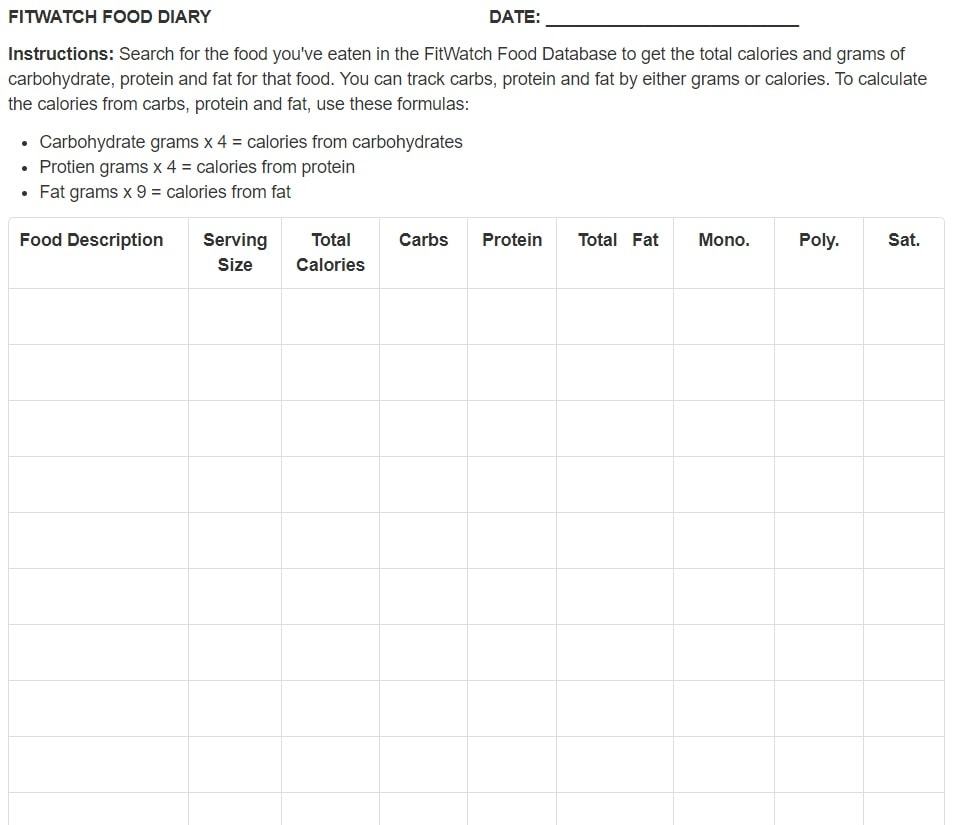
via FitWatch
In addition to logging the food you consume, this template provides spaces for tracking the amount of fats, protein, carbs, and calories in every meal. Formulas for calculating the caloric content of food items are also provided.
This tracker was developed by health and nutrition coach Suzanne Hiscock, owner of FitWatch. Through her site, she has provided support for people’s health and fitness journeys.
8. Monthly Food Tracker
This food tracker is ideal for those who want to keep a record of the types of food they are consuming. There are several reasons for doing this.
For some, it ensures that they are taking the right kinds for food—especially for someone who has a health condition that needs specific kinds of nutrients only available from certain food products. For others, it might be a way of tracking how much junk food they consume in a month, giving them accurate information on whether or not they need to cut back on chips or soda.
9. Cute Meal Tracker
If you love customizing your trackers, here is a sample for inspiration. This spread was created on a dot-grid notebook using printable stickers.
If you like this sample, you might want to check out the inspiring bullet journal layouts in this post.
10. Minimalist Meal Tracker
If you’re into lists, then this type of layout might be what you want. The creator lists all the food she’s eaten for the entire month, using single entries for every meal.
The creator of this layout didn’t record her beverages, but you can include that in your own minimalist food log.
11. Printable Daily Food Log
This food log is designed for those doing the keto diet, or any low-carb diet where one needs to monitor ketone and glucose levels. The log has boxes that users can tick for the specific meals of the day when the food was consumed, or when one is doing an intermittent fast (and for how long).
The design comes in a soothing teal, and it also has a space that allows users to record the volume of their water, wine, and condiment consumption.
12. Weekly Meals Journal for Kids
We’ve already mentioned that it’s better to help kids form healthy eating habits while they’re young. This food journal is another fun template that can help children track the food they eat. It includes suggestions for healthy food items they can try at every meal.
13. Food Tracker
Many people use food trackers for their weight-loss goals. The template above adds a fun and colorful touch to your food logging activities.
What goals can you use your food diary for? The most common uses include:
14. You Can Do It Food Journal
As with any habit, starting a food journal is often the most challenging part. Fortunately, this food tracker reminds you that “You can do it!”
Keeping a food journal for weight loss is easier if there is someone who can be your accountability partner. This person can be a friend, a family member, or your dietician—anyone who can provide the support and encouragement you need.
15. Pocket-Sized Food Journal
With this pocket-sized food tracker, it’s easier to keep tabs on the food you eat. Print it out and staple the pages together. It’s just the right size to take in your purse or wallet for easy access no matter where you go.
16. Weight Watchers Weekly Point Tracker
This is another tracker that incorporates the Weight Watchers’ point system. It features a total target point, and there are columns for points used and the balance.
17. Food Diary Ribboned
This food journal layout is designed for keeping track of your food intake for a week, as well as the exercise you do. The standout features of this template are the spaces provided to record the user’s weight at the start and at the end of the week, as well as the trackers for water intake and fruit and veggie consumption.
18. Weekly Food and Exercise Tracker
This food diary is a variation of #30. It has a minimalist design and spaces that let you track your daily water intake.
19. Cute Printable Meal Planner
If you’re looking for inspiration for a cute, minimalistic food tracker, then this template is worth checking out. It is a fairly straightforward template, bordered in candy sprinkles. It has room for you to record the three main meals of the day, as well as a single snack.
20. What I Ate
If you are into the no-fuss approach of food tracking, then this minimalistic weekly food journal might appeal to you. You can track what you ate for breakfast, lunch, and dinner, as well as snacks. There is also a column dedicated to tracking the volume of water you drink each day.
21. Emotional Eating Tracker
Research studies, such as one done at the University of Liverpool, show that emotional eating is one of the coping mechanisms of people who experience obesity. A food journal can be helpful for emotional eating.
One has to use a different approach when keeping track of what he or she eats to check for patterns of emotional eating. Instead of counting calories or servings, the user should log moods, feelings before and after eating, stress levels, and hunger levels.
The template above has a notes column where you can write your observations about things related to your emotions while you’re having a meal. We suggest working with a professional who can provide expert guidance and support on the subject of emotional eating.
22. Monday 2000 Food Journal
Monday 2000 is a nationwide campaign for better health. It is based on the recommendation that the average adult needs 2000 calories per day to maintain an ideal weight.
The template above features columns for tracking calories, protein, fat, and carbs. The goal is to consume food items that add up to only 2000 calories (or below) for the whole day.
This campaign is usually done on a Monday to raise awareness about making healthier meal choices through the rest of the week.
23. Food/Exercise Journal
This food tracker template incorporates the Weight Watchers point system, letting the user know if he or she is staying within his or her allocated number of points to control/lose weight.
The Weight Watchers program has a point system where users are assigned a set number of points every day (based on their gender, age, height, and weight), which they can use to track what they eat.
The point system is generated by an algorithm that factors in a food item’s calorie, fat, sugar, and protein content to come up with a “SmartPoint” number.
24. Weekly Food Diary
Are you looking for a grayscale template? Here’s one that not only helps you track your food intake for the entire week, but also other essential information about nutrition.
You’ll find spaces dedicated for the following:
There is also sufficient space at the bottom of the page for writing notes.
25. Pastel-Themed Food Diary
If you prefer a colorful template, here’s one featuring a pastel pink-and-blue color scheme.
This food diary is designed for daily use. It allows you to set a calorie goal, track your macros, and record your total calorie intake at every meal.
The template also comes with a hydration tracker, which ensures that you stay hydrated throughout the day. A notes section near the bottom of the page allows you to write important reminders and ideas.
26. Good Eating Habits Food Diary Template
When you want to stay motivated for your new diet, track your mood in relation to the food you consume, or keep track of your overall good habits, this food diary is a great tool for recording your progress.
This minimalist template has sections for recording and tracking the following for each day of the week:
27. Food + Fitness Tracker
This template pack contains everything you need to manifest your health and fitness goals.
Its food and fitness tracker allows you to record your food and water intake for the week. A meal plan helps you prepare dishes that comply with your dietary and fitness goals.
Meanwhile, a goals worksheet offers space for writing down your goals to motivate and inspire you to achieve them.
28. Motivational Food & Exercise Diary
Speaking of motivation, here’s a food and exercise diary designed to help you reach your goal of being healthier.
Designed for use throughout the week, it has sections for tracking your meals each day. In addition, there are spaces for the following:
The template is available for download in three different color schemes: white, blue marble, and golden chevron.
29. Food Allergy Journal
Food journals and diaries are not only useful for tracking food consumption, macros, and other nutritional information, they are also an essential tool for someone who has allergies that could be triggered by certain foods or ingredients.
This template has been designed primarily to monitor food reactions in kids. You can indicate the date and time of monitoring and it has sufficient spaces for recording what was eaten for breakfast, lunch, and dinner.
Each meal section has spaces for writing the type of food, the serving size, and your mood during that particular meal.
There is also section for taking note of any symptoms that appeared during that meal. The template also features a pre-made list of symptoms with boxes you can tick if a certain symptom manifests.
30. Tracking Your Digestive Health
While we’re on the topic of food reactions, here’s another template created specifically to track digestive health.
Some of the features you’ll find in this journal template include:
31. Mindful Eating Log
Many people have a love-hate relationship with food. Rather than associating food with joyful memories, they often feel guilty and deprive themselves. However, this deprivation can backfire and cause them to binge on unhealthy fare.
This template was designed to help food bingers develop a more mindful approach to eating and restore a healthy relationship with food. It has prompts for recording one’s eating patterns and reactions to mealtimes, as well as other activities throughout the day.
32. Blue Food Diary With Macros Log
Tracking macros helps you understand the impact of calories in your body and shows you where these calories come from.
This template provides space for recording your meals for three days. It has a section for tracking the following:
Whether you want to gain weight or to lose it, using this template supports your fitness goals.
33. Food Intake and Reactions Journal
Here’s another food journal that helps track your reactions to food. It was primarily designed to help those who are on an elimination diet record what food affects their digestive health. The template is also useful for tracking triggers of food allergies.
It has spaces allocated for writing down the date, time, and food consumed during a particular meal. It also has sections for recording any reaction and the overall feeling or mood that is prevalent during or immediately after that meal.
I Have a Food Diary, Now What?
When you’ve successfully kept a food diary for at least a week, it’s time to review how you did in terms of food consumption, and to see if there is any pattern to it.
Do you tend to eat a lot of sweets when you’re feeling low? A food diary with a mood tracker can help you detect this tendency.
Are you eating enough fruits and vegetables?
Are you hitting your macros and micros while doing a keto diet?
Did you get off track from your whole-food, plant-based diet at a family picnic?
Your food journal can help provide the big picture. This information can help you make the right decisions and choose the best course of action to take when it comes to your overall health and well-being.
Furthermore, the information you log will be of great help to your dietician or nutritionist, allowing them to plot a course of treatment or support for your specific needs.
In Conclusion
A food journal provides information about the food you eat, and can help you live a healthier life.
If it shows that there are areas to improve in your eating habits, you will be in a better position to enact the necessary changes.
But remember-as with any habit, keeping a food journal will only be successful if you do it consistently.
Can’t get enough of healthy habits? Check out this post featuring almost 200 healthy habits you can incorporate in your life this year.
Also, if you’re in need of inspiration for other habits to track aside from your food intake, you might want to head over to this post about 125 habit tracker ideas for your bullet journal or app.
Remember, consistency is the key!
Finally, if you want to take your goal-setting efforts to the next level, check out this FREE printable worksheet and a step-by-step process that will help you set effective SMART goals.

